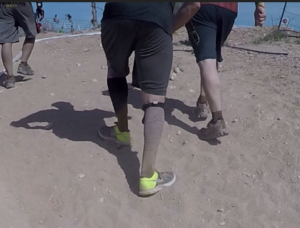I have admitted in the past to be a bit of a stalker. Not in the creepy way, but the most sincere way possible. I just can’t help myself though. I am always observing what other people do during a race.
Sometimes this is to see what common mistakes are made so I can improve my own training or to help other clients I work with. Or I might see something really cool that I never thought of before and test it out for myself.
We can learn so much when we just sit and watch what others are doing. When you watch hundreds of people move you start to see trends. Some good and some not so much.
This article is about one of the most common running compensations that I have repeatedly noticed during my last few Spartan Races. The issue is having your feet turn out when you run or even during walking up hill.
The funny thing is, you probably do this. I see more people do this than don’t. Don’t believe me? Try it out. Have someone stand behind you and film you while you run. Do your best to run naturally. After reading this you might try and fix it, but just run how you normally would run and see what your feet do.
Here is a pic for the Vegas Super where I saw someone complaining about his knees and calves killing him while walking uphill. If this was you, my apologies for posting your pic but you are going to learn exactly how to fix this below. 
And if you don’t do it right away, I bet you will start to see it happen as you fatigue. This can be a simple fix or require a little more work.
But if this is your running technique, I promise that sooner or later your knees will be completely destroyed. This type of mechanics leads to overpronation, which leads to internal rotation of the lower leg, which leads to internal rotation of the femur. This causes extra stress being placed on the inside of your knee, which will likely result in worn cartilage or even a medial meniscus tear.
There is a good change that you are already in pain when you run for a long period of time. If not you will eventually.
I’m sure that you can see from the picture above how bad this can be to continually pound the pavement with your running. So what can we do about this?
There are two approaches to fix this. The first is so easy you won’t believe that it works. You simply stop doing it! I know sounds too good to be true. For some people though, they have the ability to correct their form, without anything else.
The hardest part is knowing if you are doing it or not. So you will either need a partner for this to make sure you are running with your feet straight, or you can see if you can find a treadmill that is in front of a mirror so you can see how your feet or looking.
This quick fix might work for some. If you can correct it by simply thinking about fixing it, you just need to repeat it over and over until it becomes more natural. For many they feel like their feet are pointing in when they are really straight. Although it is uncomfortable at first it will be better over time.
Many people will not be so lucky. They will have to work harder because they are not able to get into the correct position. While there are a few things that might be at play, let’s focus on the most common.
If you lack ankle dorsiflexion, meaning your knee can’t move forward over your foot, you won’t be able to fix this issue too quickly. One of the most common issues I see, in general, is lack of ankle mobility. This is such an important element in human movement and leads to numerous issues.
So how do you know if you lack ankle dorsiflexion? Let’s test it. Stand with your shoes off and your toes about 6 inches from a wall. Keeping your heel down, drive your knee as far forward as you can, without your heel lifting and without your knee moving in. If you cannot touch your knee to the wall, you have ankle mobility issues and will likely struggle with running form. Retest on the other leg. You may have one leg that is ok and the other is lacking.
If you fell short of the wall it is time to start improving that mobility. Here is a three step process to start improving your ankle mobility.
Step 1: Foam Roll
This is a perfect place to start. Focus on the back of the leg (calf) mainly. Tightness here will not allow the ankle to fully dorsiflex. Spend about 1-2 minutes per side. Focus on any tender spots, but roll the entire area. I am a big fan of 1/2 kneeling stick work. See the videos below for to try.
Step 2: Mobility Work
There are many dorsiflexion stretches you can do, but after attending the Fundamental Capacity Screen workshop put on by Gray Cook and Functional Movement Systems, I really love this one you can do with a KB. Check out the video below. Just make sure your foot is turned out so it is at a 90 degree angle with the opposite knee.
Step 3: Strengthen The Movement
Now that you should see some improvements in mobility, you must strengthen this newly acquired range of motion. Here is a simple wall ankle dorsiflexion drill you can try. The goal is to move your knee as far forward as possible, without your heel lifting. Then tighten the muscle of the front lower leg to try and pick your foot up as you rock back. Seems simple, but when you are tight it is a struggle.
Walking on your heels might be another way to help strengthen dorsiflexion.
You probably also want to work on strengthening your knee stability by improving your abductors. Trying lateral mini band walks to help improve this.
There is a 4th step that I should mention. Once you have worked on the above you need to go run and focus on keeping those feet forward. Hopefully now you have a better chance of being able to get in that position.
Hope this helps you out with your running. I’m sure your knees will thank me at least.
Need more help on your OCR training? Make sure to check out my step up to Spartan Race Series. Learn everything you need to better prep for your next race.

